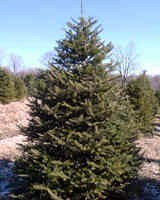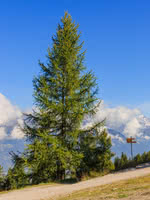Mon-Fri 9am - 5pm Mountain time
Canaan Fir vs European Larch
Abies balsamea phanerolepis
Larix decidua
CUSTOM GROW
NOT AVAILABLE THIS SEASON - MIGHT RETURN
Canaan Fir, which is closely related to Balsam Fir, is known for its open-growing patterns and strong branches.
Canaan Fir is highly adaptable to many soil conditions and thrives in both shaded areas or direct sunlight. It is commonly used for Christmas tree farming or reforestation.
This rugged landscape tree remains green year-round.
The European Larch is a large deciduous conifer that, like most larches, drops its needles before winter. Known for the soft green foliage that turns a stunning golden yellow in the fall. While young, it has a pyramidal shape with horizontal branching and drooping branches, but becomes more irregular as it matures.
The European Larch is an important timber tree in Europe.
Canaan Fir Quick Facts
European Larch Quick Facts
In row spacing: 3 m (10 ft)

